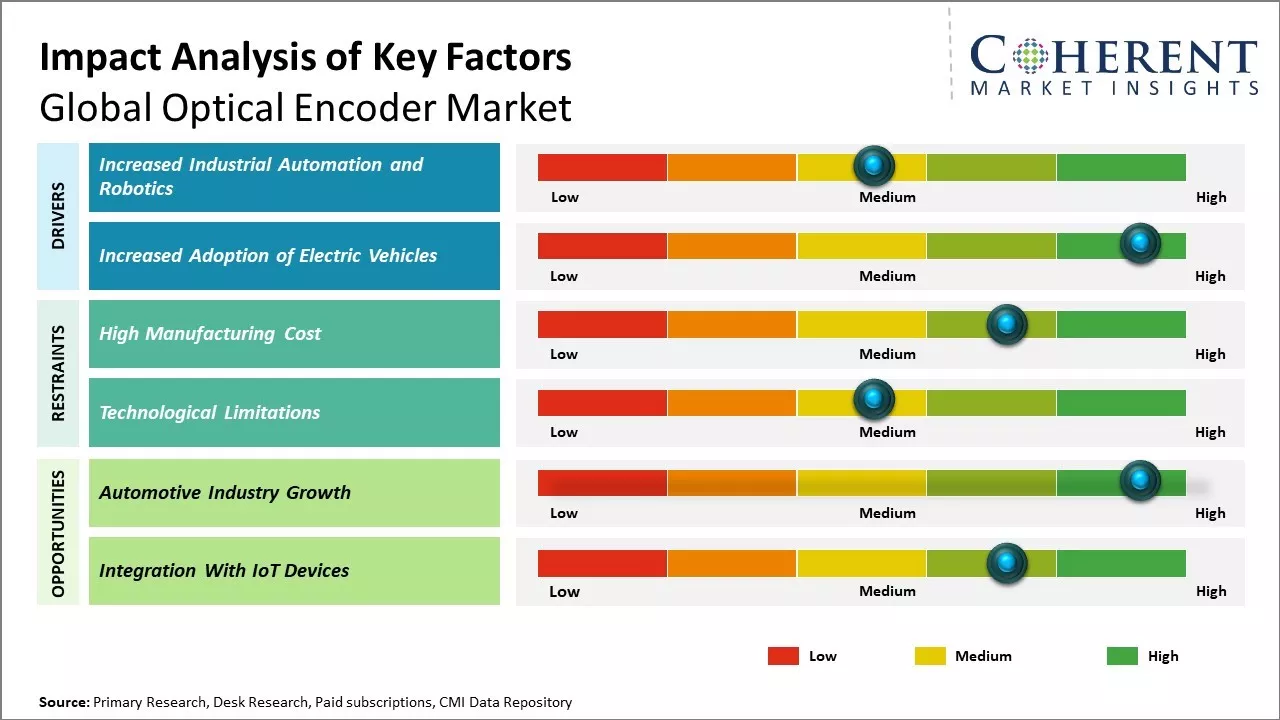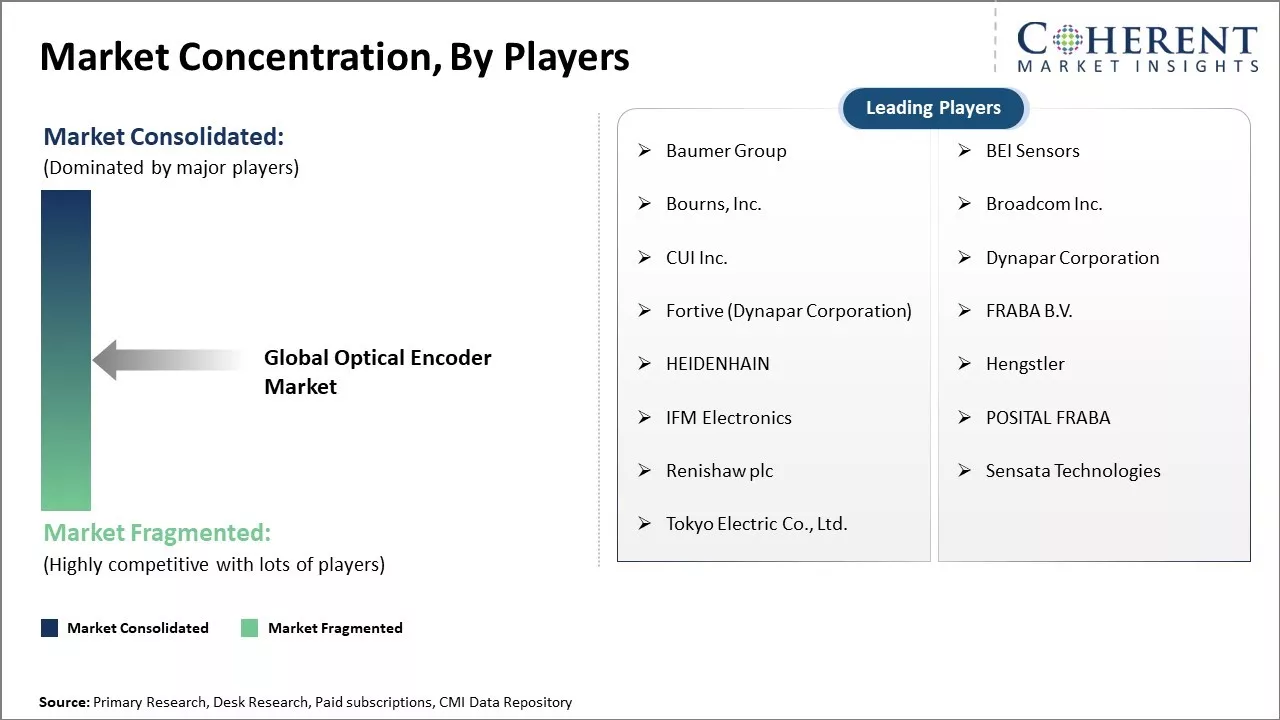
The Global Optical Encoder Market size is estimated to be valued at US$ 3,399.2 Mn in 2025 and is expected to reach US$ 8,051.6 Mn by 2032, exhibiting a compound annual growth rate (CAGR) of 13.1% from 2025 to 2032.

To learn more about this report, Download Free Sample
The Optical Encoder Market forecast is expected to witness significant growth over the forecast period. The rising demand for optical encoders from various end-use industries such as electronics, packaging, healthcare, manufacturing, and aerospace & defense is expected to drive the market growth. The adoption of sensor-based technologies to enhance efficiency and reduce downtime will further support revenue generation in the coming years. However, high initial investment for the deployment of optical encoder technology may hamper the market growth to some extent over the forecast timeframe.
|
Event |
Description and Impact |
|
Geopolitical Tensions in Semiconductor Supply Chains |
|
|
Technological Advancements in Encoder Design |
|
|
Emerging Market Industrialization |
|
Uncover macros and micros vetted on 75+ parameters: Get instant access to report

To learn more about this report, Download Free Sample
With advancements in industrial robotics and robotics technologies, the demand for optical encoders is growing rapidly across diverse manufacturing sectors. Optical encoders are essential components that play a key role in ensuring precise motion control, feedback, and positioning required for automated industrial processes and robots. They help integrate various automated machines and robotic devices within production lines at factories to improve quality, efficiency, and minimize human errors.
The ever-increasing emphasis on employing technology to improve productivity and cut costs in manufacturing processes is one of the factors propelling the growth in development of high-precision motion control systems based on optical encoders. Leading industrial robotics markets like automotive, electronics, and food & beverages are increasingly integrating robotic arms, AGVs, and other automated machinery in assembly lines, which utilize high-resolution encoders for navigation and handling tasks.
The deepening application spectrum of robotics in new verticals like logistics, healthcare, and construction is also enhancing the market potential for suppliers of optical encoders. With advancements towards Industry 4.0 transforming factory settings, automation, robotics, and IIoT solutions will be implemented globally at an accelerated pace in the coming years, thus increasing the requirements for durable optical encoders.
For example, in March 2020, the U.K. based engineering and scientific technology company Renishaw plc launched a new encoder range featuring solutions tailored for partial arc measurement applications.
Increasing global adoption of battery electric vehicles is one of the most vital factors uplifting the demand for optical encoders. Encoders ensure accurate torque control monitoring and position sensing for gear shifting, steering, and other electro-mechanical modules in electric vehicles.
Major automobile manufacturers are investing heavily in developing new models of Electric Vehicles. This is due to the strict emission policies that incentivize mobility transitions, owing to the precise feedback systems cherished by optical encoders on electric powertrains, drive units, and auxiliary components. Also driving this trend is the modern automotive complexity that drives the need for higher integration of encoders within the brake system suspension and advanced driver systems.
Research in self-driving autonomous electric vehicles is fostering the use of advanced motion control robotics employing high-resolution encoders. Further developments to improve vehicle range, efficiency, and autonomy will increase the value of encoders deployed in vehicles optical systems. Moreover, global regulations aiming to mitigate emission and fuel consumption driving urban pollution are encouraging the masses to embrace electric vehicles further heightening the market opportunities for optical encoder providers.
The automotive industry has shown robust growth over the past few years and this growth is projected to continue well into the future. As automotive production increases globally to meet the rising vehicle demand, it will drive significant opportunities for components and technologies that support automobile manufacturing.
One such component that is witnessing increased adoption is optical encoders. Optical encoders are integral to key functions in modern vehicles like engine management, transmission control, power steering, active suspension, acceleration/braking systems, and others. Their accurate motion sensing capability enables precise control and feedback required for advanced driver-assistance systems, infotainment controls, and autonomous functionalities. As automakers strive to incorporate more electronically-controlled features and transition towards electric and self-driving vehicles, their dependence on optical encoders will rise substantially.
In terms of configuration, shafted is expected to contribute 36.1% share in 2025 for the Optical Encoder Market demand owing to its precision and stability. Shafted encoders offer high resolution, repeatability, and accuracy due to the direct coupling between the code disk and signal readout system. This direct physical connection minimizes inaccuracies from vibration or shock that could occur in other encoding types.
Shafted encoders are commonly used in industrial automation equipment such as motor feedback systems, CNC machines, and industrial robots. Their robust design makes them well-suited to harsh industrial environments with particulates, temperature fluctuations, and physical vibrations. The rigid coupling of the coding element to the shaft helps provide stable, reliable position data even under demanding conditions. Additionally, shafted encoders typically offer the highest resolutions of all encoder types, making them preferable for applications requiring precise motion control or position measurements. Their precision and resilience drive the continued preference for shafted encoders in industrial applications.
In terms of output signal, digital is expected to contribute 55.6% share in 2025 for the Optical Encoder Market value owing to its precision and flexibility. Digital encoders offer increased accuracy and resolution compared to analog models as their signals contain discrete, unambiguous position values rather than continuous analog voltages. This allows for higher precision motion control and error-free position sensing. Digital outputs also provide improved noise immunity, as small voltage variations do not translate to spurious position readings.
Optical encoder manufacturers continue to add digital interfaces such as Gray code, SSI and BiSS to their product lines, driving adoption. Digital encoders offer flexible, customizable outputs that can be adapted to new protocols as interface standards evolve. Their precision digital signals and compatibility with emerging interfaces drive the growing prominence of digital optical encoders.
In terms of application, healthcare equipment is expected to contribute 34.7% share in 2025 for the Optical Encoder Market trend owing to advancements in medical technology. Optical encoders are crucial components in diverse medical devices from CT (computed tomography) and MRI (magnetic resonance imaging) imaging systems to surgical robots, rehabilitation equipment and diagnostic tools.
As healthcare technologies evolve to new standards of precision, smaller scales and sophisticated integrated designs, stringent motion control, and miniaturized sensing become essential. Optical encoders meet these demands with high resolution position feedback, resistance to sterilization, compact sizes and reliability. Their role in guiding minimally invasive surgical procedures, powering complex imaging machines, and automating rehabilitative therapies bolsters growth.
Expanding medical technology, focus on patient access to advanced care and rising healthcare expenditures worldwide continue driving incorporation of precise, versatile optical encoders. The demand for higher performance encoders from emerging healthcare applications makes this an especially dynamic market segment.

To learn more about this report, Download Free Sample
North America is projected to maintain its dominance in the global optical encoder market, accounting for an estimated 36.8% share in 2025. Such leadership is supported by the region's strong technological capabilities along with the presence of primary encoder manufacturers as US Digital, Baumer, and BEI Sensors. These companies have persistently R&D’ed, developing sophisticated encoder products for diverse industrial markets.
The region’s well-established manufacturing ecosystem encompassing automotive, machinery, and semiconductors continue driving significant demand for motion control and feedback optical encoders. Furthermore, the existing innovation ethos and industrial competence enables continuous growth in the development and integration of encoders, thereby edging out competitors on a global scale.
Asia Pacific is expected to emerge as the fastest-growing optical encoder market globally over the forecast period. Countries such as China, Japan, South Korea, and India are witnessing robust industrial growth, driven by rising investments in automation and advanced manufacturing technologies. This industrial expansion has significantly increased the adoption of optical encoders across sectors like electronics and automotive production.
The region also benefits from cost-effective labor and manufacturing capabilities, enabling encoder producers to establish competitive production hubs. This not only enhances affordability but also broadens market accessibility across developing economies. Growing cross-border trade and the region’s integration into global supply chains are further propelling market expansion.
The primary contributor to the North American market of Optical Encoders remains the United States. Its Optical Encoder market is driven by high demand from end-use industries as well as domestic R&D funding. The sustained growth of the U.S optical encoder market is aided by their strategic partnerships and bolstered by advanced automation of industrial processes. The country is home to leading encoder developers and system integrators who continue to pioneer high-performance encoder technologies further strengthening its position. The U.S. is well known for having a technologically advanced manufacturing sector.
China is aiding the growth of the Asia Pacific optical encoder market. The government focus on smart manufacturing, expanding electronics production and rapid industrialization are great contributors for increased encoder adoption. These favorable conditions is attracting both domestic and international players due to the country’s growing environment for manufacturing. China is quickly becoming a global hub for encoder manufacturing. Furthermore, policies that support domestic innovation are aiding in their strong growth.
| Report Coverage | Details | ||
|---|---|---|---|
| Base Year: | 2024 | Market Size in 2025: | USD 3,399.2 Mn |
| Historical Data for: | 2020 To 2024 | Forecast Period: | 2025 To 2032 |
| Forecast Period 2025 to 2032 CAGR: | 13.1% | 2032 Value Projection: | USD 8,051.6 Mn |
| Geographies covered: |
|
||
| Segments covered: |
|
||
| Companies covered: |
Baumer Group, BEI Sensors, Bourns, Inc., Broadcom Inc., CUI Inc., Dynapar Corporation, Fortive (Dynapar Corporation), FRABA B.V., HEIDENHAIN, Hengstler, IFM Electronics, POSITAL FRABA, Renishaw plc, Sensata Technologies, and Tokyo Electric Co., Ltd. |
||
| Growth Drivers: |
|
||
| Restraints & Challenges: |
|
||
Uncover macros and micros vetted on 75+ parameters: Get instant access to report
Share
Share
About Author
Monica Shevgan has 9+ years of experience in market research and business consulting driving client-centric product delivery of the Information and Communication Technology (ICT) team, enhancing client experiences, and shaping business strategy for optimal outcomes. Passionate about client success.
Missing comfort of reading report in your local language? Find your preferred language :
Transform your Strategy with Exclusive Trending Reports :
Frequently Asked Questions
Joining thousands of companies around the world committed to making the Excellent Business Solutions.
View All Our Clients